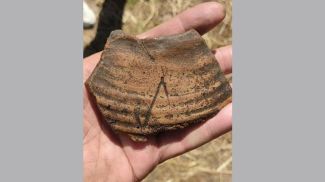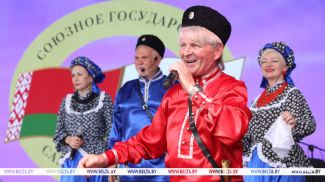An experimental facility to make human lactoferrin out of milk produced by transgenic goats operates in Minsk. Lactoferrin is a beneficial protein with many qualities with a lot of promise for making lactoferrin-based food, biologically active supplements, medications, perfumery, and cosmetics. BelTA reporters visited the enterprise to learn what products exactly will be made in Belarus out of the unique protein.
For the first time ever Belarusian and Russian scientists have created herds of transgenic goats that can produce recombinant human lactoferrin. Human genes are now part of the goat DNA. The project was implemented as part of the Belarus-Russia Union State programs BelRosTransgen and BelRosTransgen 2. Lactoferrin boasts antibacterial, antiviral, antimicrobial, anticarcinogenic, anti-inflammatory, immunomodulatory, antioxidative, and regenerative qualities. The global demand for lactoferrin is estimated at 90 tonnes per annum.
The Belarusian and Russian scientists spent about 15 years working towards the establishment of the experimental lab that can make lactoferrin. At long last the facility was opened in the Microbiology Institute of the National Academy of Sciences of Belarus on 26 October 2016. Alexander Kostenevich, head of the protein lab and the lactoferrin-manufacturing facility in the Microbiology Institute, noted: “It is an absolutely unique project. Japan and America use lactoferrin made out of cow milk. That kind of lactoferrin is used to make food and biologically active supplements. There is another variety made out of human breast milk. However, it is prohibitively expensive and the raw materials are hard to come by. Industrial production out of that kind of milk is impossible. We've managed to distill human lactoferrin out of milk produced by transgenic goats, which DNA now implements human genes. The transgenic goat lactoferrin differs from the cow milk lactoferrin in content and boasts action mechanism advantages. Transgenic goat lactoferrin can be used for industrial production. It is possible to make and export products based on this kind of lactoferrin.” There are plans to make up to 5kg of lactoferrin per annum.
The scientists are busy working on a project to make baby formulas based on lactoferrin and some additional whey proteins. The formulas are expected to have a favorable effect on human organism. The project will be finished within two years. “It will be an absolutely new product for our country. I should note that the product cannot be described as genetically modified although it will be made out of transgenic goat milk,” stressed Alexander Kostenevich.
There are plans to make biologically active supplements because lactoferrin boasts antimicrobial and antiviral qualities. It will be possible to make a lactoferrin-powered medication in the more distant future. “However, medics will have to spend many years doing clinical trials in order to find out all the peculiarities the medication may have,” said the lab head.
Making lactoferrin involves several stages. The transgenic goats are taken care of by personnel of the animal husbandry R&D center of the National Academy of Sciences of Belarus. Goat milk is frozen and delivered to the experimental manufacturing facility. Here milk is unfrozen and defatted using a separator.
After that milk is subjected to microfiltration to remove bacteria and casein proteins, which final product does not need. Whey is the result. Lactoferrin is one of the proteins this whey contains.
Chromatography comes next. A chromatographer can separate lactoferrin from other whey proteins and produce lactoferrin as reddish liquid that also contains water and salts. An ultrafiltration plant is used to remove water and salts in order to increase lactoferrin content.
High-vacuum freeze drying is the final part of the process. The dryer can produce lactoferrin as rosy powder.
Shortly after the startup and commissioning operations and the first run of the equipment the scientists managed to produce 24g of lactoferrin. Some is being examined in the Microbiology Institute. Some has been handed over to other organizations of the National Academy of Sciences of Belarus. The scientists are studying antimicrobial, immunopotentiating, physical parameters and other qualities of the product. “We are constantly working to improve the lactoferrin manufacturing technology, optimizing it and making it better,” said Alexander Kostenevich.
Human lactoferrin made out of transgenic goat milk and the unique lactoferrin manufacturing facility will be presented during Foodex Japan 2017 in March. Negotiations on exporting lactoferrin to Japan are already in progress.













